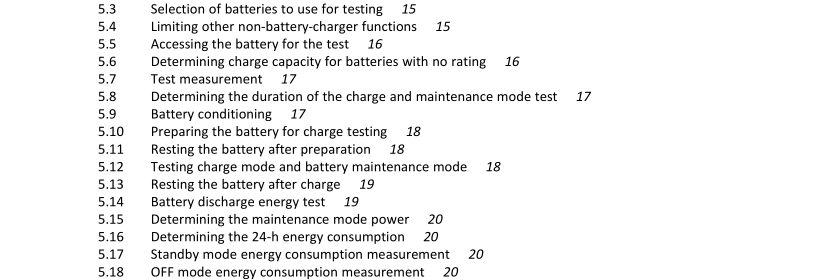CSA C381.2-17 pdf download – Energy performance of battery-charging systems and uninterruptible power supplies.
4 General conditions for testing battery chargers other than UPS 4.1 General Unless otherwise specified, measurements shall be made under the test conditions and with the equipment specified in Clause 4. The values that may be measured or calculated during the conduct of this test procedure have been summarized for easy reference in Table 1. 4.2 Verifying accuracy and precision of measuring equipment Any power measurement equipment utilized for testing shall conform to the uncertainty and resolution requirements outlined in Clause 4 (“General conditions for measurements”), as well as Annexes B (“Notes on the measurement of low power modes”), and D (“Determination of uncertainty of measurement”) of CAN/CSA-C62301. 4.3 Sample size and represented values Note: See Annex A for guidance on sampling size. 4.3.1 For a basic model, a sample of sufficient size shall be randomly selected and tested to ensure that the represented value of unit energy consumption (UEC) is greater than or equal to the higher of a) the mean of the sample; or b) the upper 97.5% confidence limit of the true mean, divided by 1.05. 4.3.2 The sample from Clause 4.3.1 shall be used to calculate the additional represented values for a basic model. Additional represented values are the sample mean values for each of the following metrics: a) battery discharge energy (E batt ) in watt-hours (Wh), b) 24-hour energy consumption (E 24 ) in watt-hours (Wh), c) maintenance mode power (P m ) in watts (W), d) standby mode power (P sb ) in watts (W), e) OFF mode power (P off ) in watts (W), and f) duration of the charge and maintenance mode test (t cd ) in hours (h).
4.5 Verifying the UUT’s input voltage and input frequency Verification of the UUT’s input voltage and input frequency shall meet the following requirements: a) If the UUT is intended for operation on ac line-voltage input, it shall be tested at 115 V at 60 Hz. If the UUT is intended for operation on ac line-voltage input, but cannot be operated at 115 V at 60 Hz, it shall not be tested. b) If a charger is powered by a low-voltage dc or ac input, and the manufacturer packages the charger with a wall adapter, or sells or recommends an optional wall adapter capable of providing that low voltage input, then the charger shall be tested using that wall adapter and the input reference source shall be 115 V at 60 Hz. If the wall adapter cannot be operated with ac input voltage at 115 V at 60 Hz, the charger shall not be tested. c) If the UUT is designed for operation only on dc input voltage and the provisions of Item b) do not apply. It shall be tested with one of the following input voltages: 5.0 V dc for products drawing power from a computer USB port or the midpoint of the rated input voltage range for all other products. The input voltage shall be within ±1% of the above specified voltage. d) If the input voltage is ac, the input frequency shall be within ±1% of the specified frequency. The THD of the input voltage shall be ≤2%, up to and including the 13th harmonic. The crest factor of the input voltage shall be between 1.34 and 1.49. e) If the input voltage is dc, the ac ripple voltage (RMS) shall be i) ≤ 0.2 V for dc voltages up to 10 V; or ii) ≤ 2% of the dc voltage for dc voltages over 10 V. 4.6 Test leads Leads used in the test set-up shall be of large gauge and short length in order to avoid the introduction of errors into the testing process. Note: For further guidance, see Table B.2 of IEEE 1515.CSA C381.2-17 pdf download.
